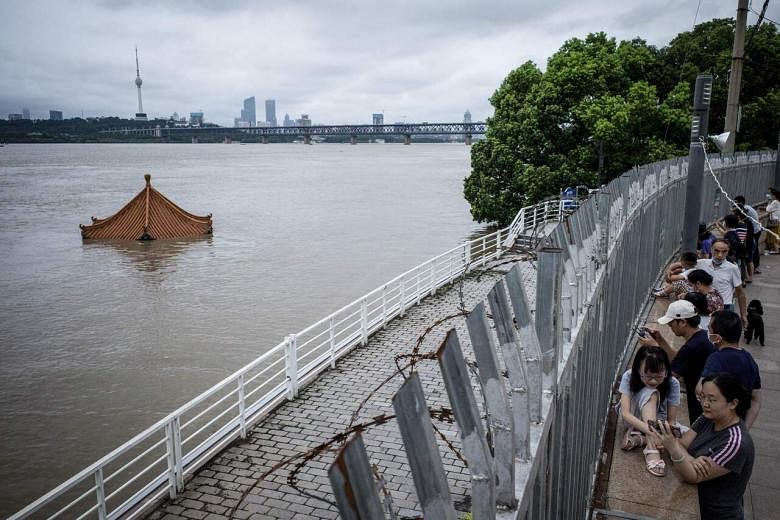BEIJING (CHINA DAILY/ASIA NEWS NETWORK) - Authorities have warned of the possibility of major floods in China's northern areas as inundations continue to cause serious damage in many parts of the southern half of the country, especially along the Yangtze River's middle and lower reaches.
Since June, high-water alerts have been triggered along 433 rain-swollen rivers. Only 11 are in the Yellow River Basin in the north, while all others are in southern areas, said Mr Ye Jianchun, vice-minister of water resources, at a news conference organised by the State Council Information Office in Beijing on Monday (July 13).
While high water levels linger in the Yangtze and Taihu Lake, more rain than normal is expected in some northern areas as the region prepares to enter its rainy season, usually from late July to early August, he said.
Major floods may occur in the Songhua, Liaohe, Haihe and Huaihe river basins and the middle reaches of the Yellow River, he added.
"There has been no flooding in these river basins for years. People are not very knowledgeable about flood control there, and local flood control capabilities are comparatively weak," Mr Ye said.
The ministry will guide northern regions in rolling out precautionary measures as it continues to contribute to efforts in the south, he said.
"The current flood control situation in Yangtze and Taihu remains grim," he said.
Most of the Yangtze's middle and lower reaches have seen water swell above their warning levels. Meanwhile, the water level in Taihu Lake in the lower Yangtze area is forecast to keep rising and may exceed 4.65 metres, the maximum level that its dikes are designed to hold, Mr Ye said.
On Monday, however, southern areas had a rare rain-free day, according to the National Meteorological Centre. Before that, the centre had issued new alerts for torrential rains for 40 consecutive days starting June 2. Rain will return to the region, however, from Tuesday to Thursday.
At 8am on Monday, the level of Poyang Lake, China's largest freshwater lake, reached 22.6 metres.
On Sunday, it had surpassed its historic high of 22.52 metres, recorded during the devastating floods of 1998, Jiangxi provincial authorities said. The lake is connected to the Yangtze River water system.
"Though some hydrological stations in Poyang reported higher water levels compared with records in 1998, water levels in major hydrological stations in middle and lower reaches of the Yangtze are currently below those of that year," Mr Ye said.
Vice-Minister of Emergency Management Zheng Guoguang said that even though rainfall in the Yangtze Basin has been 51 per cent above normal this year, "the likelihood is not great" that the type of prolonged, concentrated precipitation that happened in 1998 will occur.
Also, with construction of more water conservancy projects and an improved system to handle floodwaters, "we have had much stronger flood control capability", he said.
Meanwhile, several thousand people have returned to Jiangzhou town, Jiangxi province, to save their hometown from being flooded after the local flood control authority said in a letter that it was severely short-handed and needed young people to come home to help battle the swelling Yangtze River.
After reading the letter on social media on Saturday, Ms Xu Xin immediately forwarded it on her WeChat account and asked if anyone else wanted to come along to help protect her hometown.
Jiangzhou is on an island surrounded by the Yangtze River, so flood control activities in the summer are familiar to the 20-year-old, who was born in the township in Jiujiang city.
Although she moved to the urban area of the city when she was a child, Ms Xu often comes back during Spring Festival and school holidays, she said on Monday.
"This year, the flood is something else. It came much earlier, and the water level is shocking," said Ms Xu, who is a student at Jiangsu Vocational College of Finance and Economics in Huai'an city and returned home for summer holiday. "Many houses near the ferry dock of Jiangzhou are already underwater."
There are only about 7,000 people living in Jiangzhou, and many of them are older people. Fewer than 1,000 people are capable of carrying out flood control activities and defending the 34.6-km dam. The town is severely shorthanded in terms of flood control workers, the letter issued on July 10 said.
An average of 1,000 people have returned to join flood control work every day since the letter was published, Luo Yun, Party chief of the Jiangzhou water resource commission, told CCTV on Sunday.
Meanwhile, more than 650 troops from the People's Liberation Army and armed police officers have arrived in Jiangzhou to help fight the flood, the authority said.

